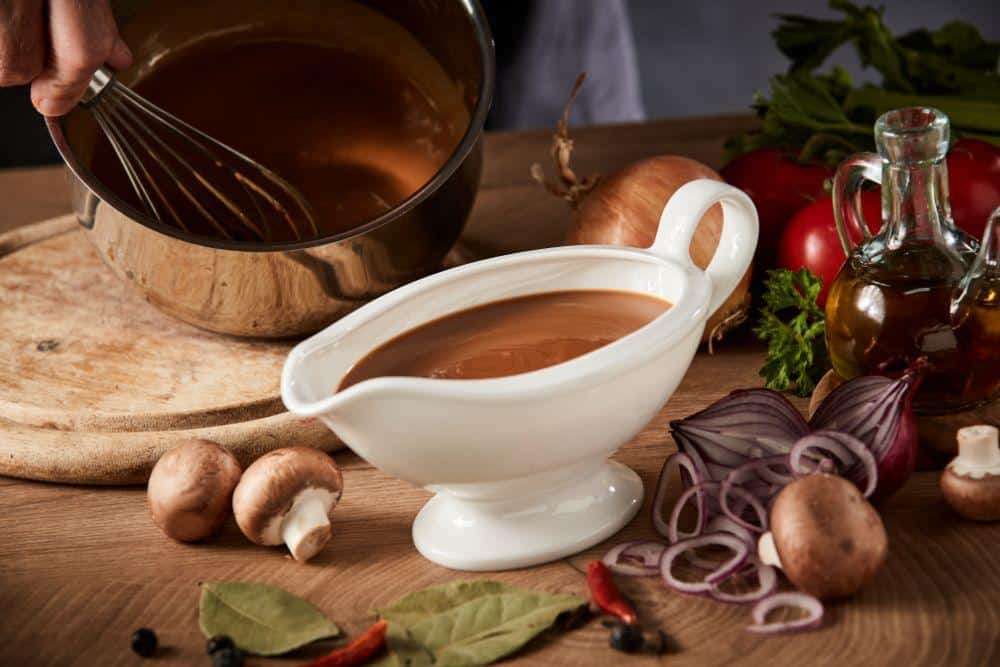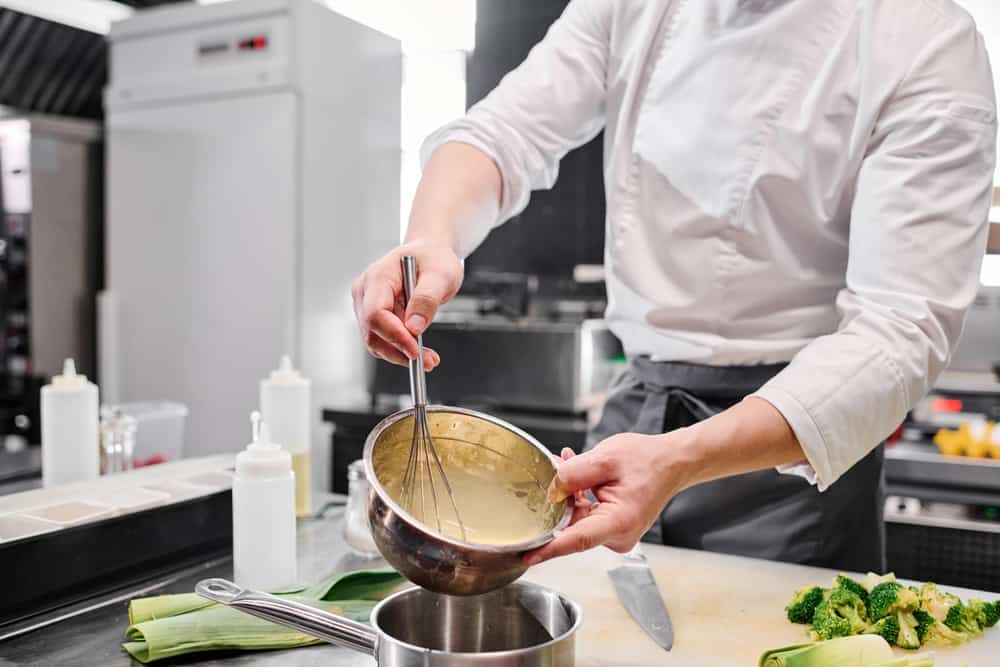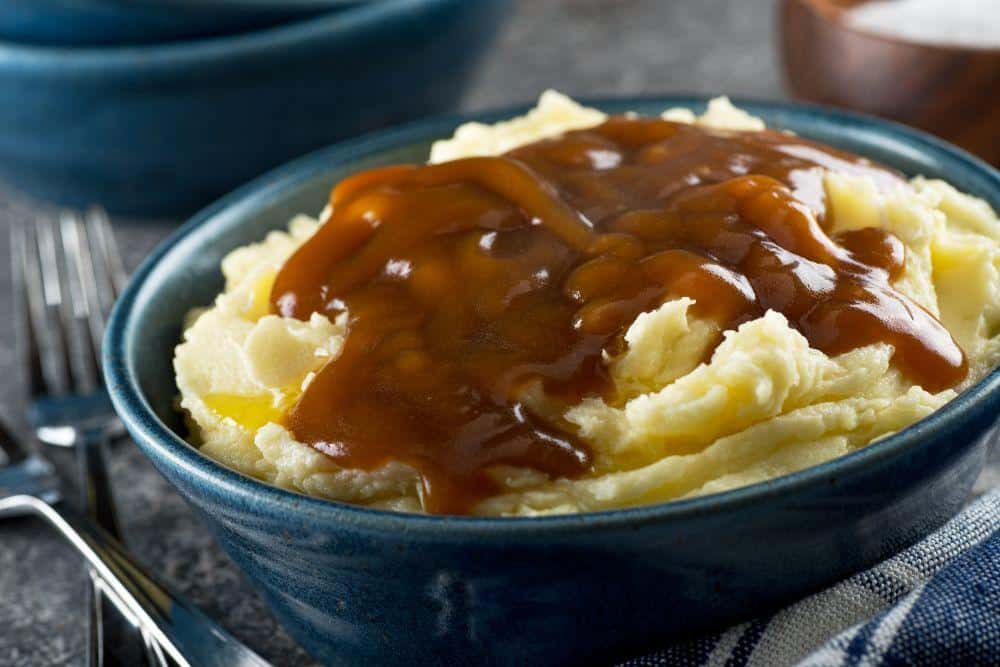Nobody wants to dig into a delicious meal to find lumps of flour or cornstarch in their gravy.
Fortunately, you can use a few techniques to keep lumps from forming in the first place. And if you end up with lumpy gravy or sauce, don't worry. You'll be able to fix it.

The Goal: Smooth Gravy that is Free of Lumps
If you've ever been frustrated and wondered how to get lumps out of gravy, you'll find several methods for preventing lumps, and fixing them below.
Flour and cornstarch are typically the thickeners used to make homemade gravy. The most basic gravy recipe starts with fat and flour cooked together to create a roux that will thicken it, then broth, milk, or cream poured into the pan.
The fat can be oil, butter, or lard, but it's often hot fat left in a pan from cooking meat. Homemade white gravy to go over biscuits, for instance, starts with the sausage fat left in the skillet, known as pan drippings.
Some of the grease left from fried chicken cooked with flour and mixed with cream or milk makes cream or milk gravy. Turkey gravy and other broth-based brown gravy varieties don't use milk or cream, just the broth, and roux.
If the flour isn't mixed properly into the gravy, it often clumps and causes lumpy gravy. Cornstarch used to thicken broth instead of a roux needs thorough mixing to avoid a cornstarch lump or two.
You can prevent lumps in your sauces and gravies by:
Lumps will sometimes form despite your best efforts, but if you use one of these methods, it's less likely to happen.
To make a roux from flour and fat according to your gravy recipe, you must vigorously whisk while adding the broth, milk, or cream. Add the liquid slowly so you can incorporate the roux well.
If you add the liquid too fast, it's much harder to keep the roux from clumping or thickening the gravy unevenly.
Making Turkey Gravy - According to McCormick
Some gravies don't start with a fat and flour mixture. You can make a gravy from chicken broth or the meat drippings left in a roasting pan after making turkey or roast without a roux. If you forgot to add thickener as a first step, you wouldn't have to use a separate pan to make a roux.
You can add flour or cornstarch to the broth to thicken it into a gravy. Use a sifter or a strainer with a fine mesh. A plastic colander has large holes that won't help, but a metal sieve works well.
Put your thickener in the sifter and tap it to sprinkle on top of the liquid while stirring. Then wait until you've mixed in all the thickener before you add another light dusting of the thickener.
This method takes patience and time. Putting too much flour or cornstarch into the pan at once will take a lot of whisking and may still form lumps.
A flour or cornstarch slurry can help prevent lumpy gravy because the thickener dissolves before you add it.
You'll need to mix the thickener with cool, not hot, liquid, or the heat can cause it to clump. Add either one tablespoon of cornstarch or two tablespoons of flour to a cup of cool water, broth, or other liquid.
Stir or whisk this until it's smooth, then add it slowly to the liquid in the hot pan while you whisk. Pour it as if you were dripping milk into an almost-full coffee cup while trying to keep it from overflowing.
Corn starch works best for thickening gravy if you find some of your sauces have a slight taste of flour. You can use half as much cornstarch, so it's less obvious in the finished gravy.
If you tried these methods or made your homemade brown gravy differently, you could still need to fix lumpy gravy. The same techniques work for any cooked sauce.
Whisking is the most labor-intensive, and blending is the fastest. Straining is a low-tech way to fix lumpy gravy if you don't have a blending appliance or don't want to wash it afterward.

More Intense Whisking Can Sometimes Eliminate those Stubborn Gravy Lumps
When you add anything, whether a thickener or the main liquid, to the hot pan juice, you must constantly whisk to prevent lumps. Vigorous, steady whisking will often break up the clumps if that doesn't work.
If you use cornstarch to thicken gravy and stir too much, it can start to thin again, so if the lumps don't go away after several minutes, try a different method.
If you have a fine-mesh strainer or sieve, you can put it over a pot or bowl and pour the lumpy mixture into it. The mesh will catch the lumps and leave you with a gravy that will look smooth and delicious on top of mashed potatoes.

Straining is Another Way to Ensure the Gravy on Your Mashed Potatoes is Sans Lumps
If your gravy has specks of flour or cornstarch and your sieve is too large-mesh to catch them, you can rub the mesh with the back of a spoon to try to mash up any tiny particles.
If that doesn't work, pull out an appliance.
Pour the lumpy gravy into a blender and choose one of the fastest settings like puree or whip. Lumps don't stand a chance against a blender.
If you don't have a blender, use a food processor on a high setting for a couple of minutes until the lumps are gone. An electric mixer can work if you don't have another appliance.
You don't need a high-speed or powerful personal blender that crushes ice. Any blender with a puree or equivalent setting will fix lumpy gravy.
Be careful when blending hot liquids in an enclosure blender because pressure can build. Open the small vent in the top, or remove the lid between blends to let steam escape.
